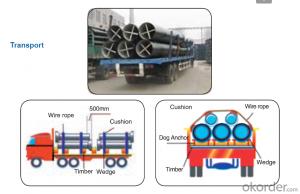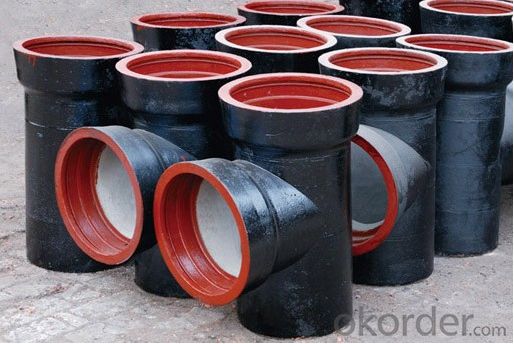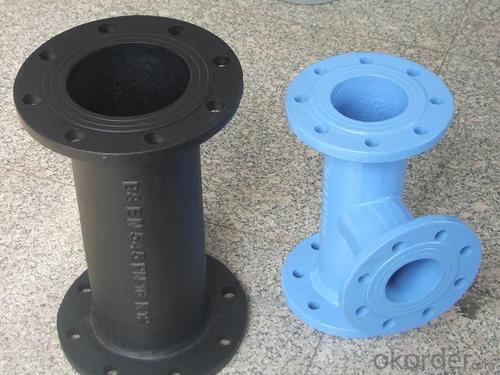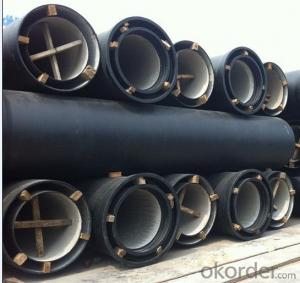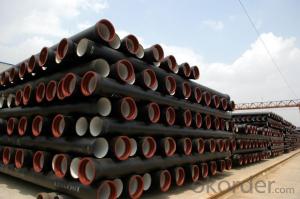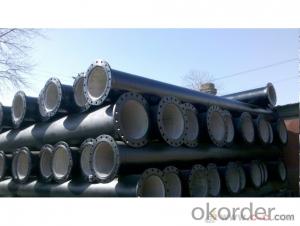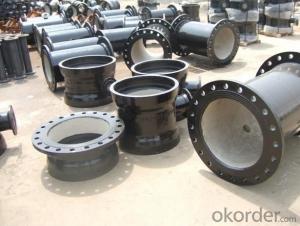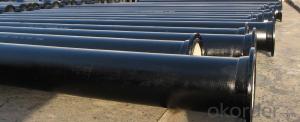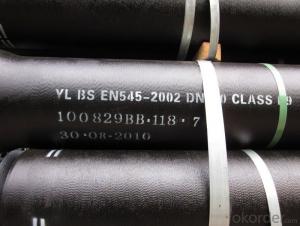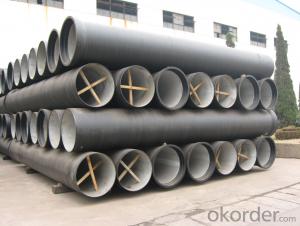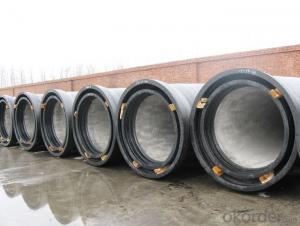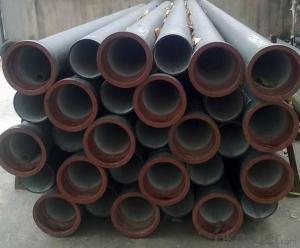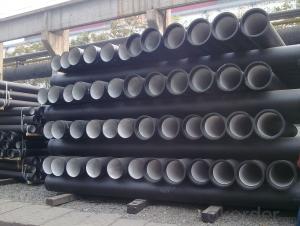Duct Iron Pipe DI Pipe Flange Pipe with Welded ISO 2531 EN545
- Loading Port:
- Tianjin
- Payment Terms:
- TT OR LC
- Min Order Qty:
- 100 m
- Supply Capability:
- 100000 m/month
OKorder Service Pledge
OKorder Financial Service
You Might Also Like
Ductile iron pipe fittings:
1.Ductile iron fitting
2.EN545/ISO2531
3.Epoxy Internal and external
1), Product Information
Ductile Cast Iron Pipe Fitting & coupling manufactured by Xinxing Pipe Fittings Co., Ltd is mainly used for transferring the drinkable water and acid. With special ductile iron material, this series of pipe fittings can also be used for transferring the acid in the acid plant or transferring slurry. Xinxing Pipe Fittings Co., Ltd has been supplying Pipe Fittings for over 10 years and Pipe Fitting surface shall be smooth and free from sand holes, blow holes, distortion or any other defects. Hundreds of patterns are ready and Max. dia. is 1.2 meters with max. height of 2 meters.
2), Material
* Ductile Iron
3), Process
* Automatics machine lines
* Resin Sand
* Molding Boards
* Green Sand with hand molding
4), Inscription Style
* XinXing Foundry
* As per customers' requests
* Standard Inscription
5), Packing
* Plywood pallet
* Steel pallet
* As per customers' requirements
6), Inspection
* Foundry in-house
* Third Party inspection available upon request


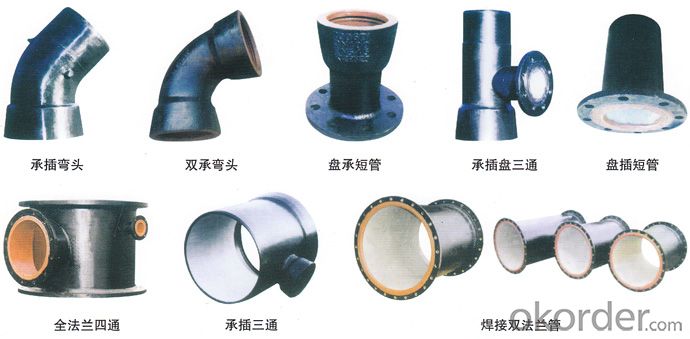
Transport:
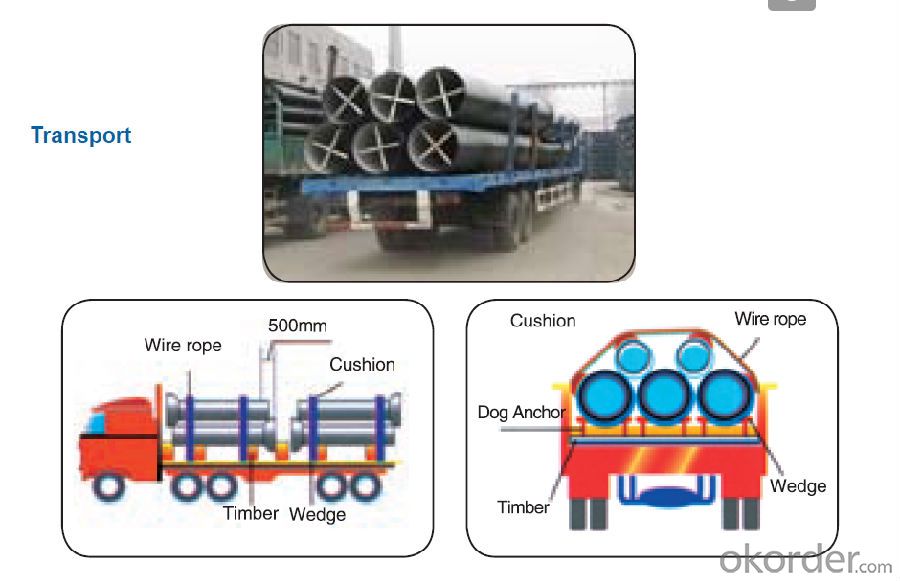
- Q: How are ductile iron pipes protected against abrasion or wear?
- Various methods and protective coatings are utilized to protect ductile iron pipes against abrasion or wear. One commonly employed method involves the application of cement mortar lining on the inner surface of the pipe. This creates a smooth and durable layer that effectively resists the damaging effects of flowing water and other substances passing through the pipe. Furthermore, external protection for ductile iron pipes can be achieved by applying a bituminous or epoxy coating. These coatings act as a barrier, safeguarding against external factors like soil or chemicals that may lead to wear or corrosion. By serving as a protective layer, they prevent direct contact between the iron pipe and the surrounding environment. Moreover, in areas where severe abrasion or wear conditions are prevalent, special linings or coatings can be applied. Polyethylene encasement or polyurethane lining can be utilized to provide enhanced protection against abrasion, especially in regions where the pipe is exposed to high turbulence or abrasive materials. In certain cases, ductile iron pipes can also be reinforced with additional materials such as fiberglass or steel wire to increase their resistance to abrasion or wear. These reinforcements offer an extra layer of protection, strengthening the pipe and reducing the likelihood of damage. Overall, ductile iron pipes are designed with a combination of protective measures to ensure their durability and resistance to abrasion or wear. These measures encompass cement mortar linings, protective coatings, special linings or coatings for severe conditions, and reinforcements. These protective methods play a crucial role in prolonging the lifespan of the pipes and maintaining their functionality even in challenging environments.
- Q: Are ductile iron pipes suitable for use in irrigation sprinkler systems?
- Ductile iron pipes, known for their durability, strength, and corrosion resistance, are a suitable option for irrigation sprinkler systems. With their high tensile strength, they can withstand heavy loads and high pressure, ensuring a consistent water supply. Moreover, their long lifespan reduces the frequency of maintenance and replacement, making them cost-effective. In summary, ductile iron pipes are reliable and appropriate for use in irrigation sprinkler systems.
- Q: Are ductile iron pipes more resistant to breaks and cracks than other pipe materials?
- Ductile iron pipes generally possess higher resistance to breaks and cracks compared to other pipe materials. Ductile iron, a form of cast iron treated with magnesium, exhibits increased flexibility and reduced brittleness. This enhanced flexibility empowers ductile iron pipes to endure significant pressure and external loads without incurring damage. In contrast to widely-used pipe materials such as PVC, HDPE, or steel, ductile iron pipes excel in strength and durability. They boast higher tensile strength, enabling them to withstand greater forces and pressures without succumbing to failure. Additionally, ductile iron pipes demonstrate superior impact resistance, reducing the likelihood of cracking or breaking when subjected to sudden impacts or external loads. Another advantage of ductile iron pipes lies in their ability to resist corrosion. The material naturally repels rust and remains unaffected by harsh environmental conditions, making it ideal for underground installations or areas with corrosive soils. This corrosion resistance further contributes to the pipes' longevity and overall integrity. Furthermore, ductile iron pipes possess a longer lifespan compared to other pipe materials. They are designed to endure for multiple decades, often exceeding 50 years, with minimal maintenance. This prolonged lifespan decreases the necessity for frequent replacements, resulting in time and cost savings in the long term. However, it is crucial to acknowledge that no material is entirely immune to damage or failure. Proper installation, maintenance, and adherence to industry standards and guidelines are imperative to ensure optimal performance and longevity of ductile iron pipes. Regular inspection and monitoring should also be carried out to identify potential issues or signs of deterioration, facilitating timely repairs or replacements.
- Q: What is the expected deflection of ductile iron pipes under load?
- The deflection of ductile iron pipes under load can vary depending on several factors, including diameter, wall thickness, material properties, and the magnitude and distribution of the load applied. Ductile iron pipes generally possess a high resistance to deflection due to their inherent strength and durability. They are designed to withstand substantial loads and are commonly used in applications where high pressure and heavy loads are anticipated. Engineers typically employ structural analysis techniques such as finite element analysis or beam theory calculations to ascertain the expected deflection. These methods consider the specific geometry and material properties of the ductile iron pipe to predict its behavior under load. In practice, ductile iron pipes are designed with a maximum allowable deflection, which is usually specified by industry standards or local regulations. This maximum allowable deflection ensures the pipe's structural integrity and functionality. It is worth noting that the expected deflection of ductile iron pipes can also be influenced by external factors like soil conditions, installation methods, and temperature fluctuations. Therefore, it is crucial to employ proper installation techniques and adhere to industry guidelines to ensure the pipes perform as expected and meet the required deflection limits.
- Q: What is the disadvantage of nodular cast iron in excess of silicon?
- Therefore, the increase of silicon content in nodular iron greatly improves the strength index and reduces toughness. Ductile iron has a greater crystalline undercooling and a tendency to chill when treated by spheroidizing, and silicon reduces this tendency.
- Q: Are ductile iron pipes resistant to biological growth?
- Yes, ductile iron pipes are generally resistant to biological growth. The smooth interior surface of ductile iron pipes prevents the buildup of biofilm and inhibits the growth of bacteria and other organisms. Additionally, the material itself is not conducive to the growth of biological contaminants, making ductile iron pipes a reliable choice for water and wastewater applications.
- Q: How do ductile iron pipes perform in high-traffic areas?
- Ductile iron pipes perform exceptionally well in high-traffic areas due to their inherent strength and durability. These pipes are manufactured using a unique composition that includes graphite nodules, which give them their characteristic ductility. This ductility allows the pipes to flex and withstand heavy loads and vibrations caused by traffic without cracking or breaking. In high-traffic areas, where the ground is subject to constant movement and heavy loads from vehicles, ductile iron pipes offer superior resistance to stress and impact. Their ability to absorb and distribute the pressure from traffic ensures that these pipes maintain their structural integrity over time. This is particularly important as any damage or failure in a pipe system can result in costly repairs and disruptions to the water supply. Furthermore, ductile iron pipes are highly resistant to corrosion, making them suitable for installation in high-traffic areas exposed to various environmental conditions. The pipes are typically lined with a protective layer, such as cement mortar or epoxy, which provides an additional barrier against external factors. This corrosion resistance ensures the longevity of the pipes, reducing the need for frequent maintenance or replacement. Additionally, ductile iron pipes have excellent flow characteristics, allowing for efficient water distribution even in areas with high traffic demands. Their smooth interior surface minimizes friction and pressure losses, ensuring a consistent and reliable water supply to meet the needs of the surrounding population. Overall, ductile iron pipes are a reliable and robust choice for high-traffic areas. Their strength, durability, corrosion resistance, and efficient flow characteristics make them well-suited for withstanding the demands and challenges posed by heavy traffic, ensuring the continuous supply of water without compromising the structural integrity of the pipe system.
- Q: Can ductile iron pipe be used for cooling water systems?
- Yes, ductile iron pipe can be used for cooling water systems. Ductile iron pipe has excellent corrosion resistance, high tensile strength, and is capable of withstanding high-pressure conditions, making it suitable for various applications, including cooling water systems. Its durable and versatile nature allows it to effectively transport and distribute cooling water without the risk of leakage or failure. Additionally, ductile iron pipe is known for its long service life and low maintenance requirements, making it a cost-effective choice for cooling water systems.
- Q: Are there any specific standards or regulations for ductile iron pipe?
- Yes, there are specific standards and regulations for ductile iron pipe. The American Water Works Association (AWWA) has established standards such as AWWA C151 for ductile iron pipe, which outlines the minimum requirements for manufacturing, testing, and installation. Additionally, various countries and regions may have their own specific regulations and standards for ductile iron pipe to ensure its quality and performance in different applications.
- Q: How do ductile iron pipes handle seismic movements?
- Ductile iron pipes are known for their excellent ability to handle seismic movements. This is due to their unique properties and construction, which make them highly resistant to stress and deformation caused by ground vibrations during earthquakes. One of the key advantages of ductile iron pipes is their high tensile strength. This means that they can withstand significant forces without breaking or rupturing. When seismic movements occur, the pipes are able to flex and absorb the energy generated by the ground vibrations, thereby minimizing the risk of damage or failure. Additionally, ductile iron pipes have excellent resilience, meaning they can return to their original shape after being subjected to external forces. This property allows the pipes to adapt to the ground movements during earthquakes and reduce the likelihood of fractures or leaks. Furthermore, ductile iron pipes have considerable ductility, meaning they can deform without fracturing. This characteristic is crucial during seismic events as it allows the pipes to absorb the energy generated by the ground vibrations by deforming and then returning to their original shape once the seismic activity subsides. To further enhance their ability to handle seismic movements, ductile iron pipes are often designed and installed with flexible joints. These joints allow the pipes to move and adjust to the ground movements, providing additional protection against damage or failure. Overall, ductile iron pipes have proven to be highly reliable and resilient in withstanding seismic movements. Their combination of high tensile strength, resilience, and ductility make them an ideal choice for regions prone to earthquakes, ensuring the safety and longevity of fluid transportation systems.
Send your message to us
Duct Iron Pipe DI Pipe Flange Pipe with Welded ISO 2531 EN545
- Loading Port:
- Tianjin
- Payment Terms:
- TT OR LC
- Min Order Qty:
- 100 m
- Supply Capability:
- 100000 m/month
OKorder Service Pledge
OKorder Financial Service
Similar products
Hot products
Hot Searches
Related keywords


